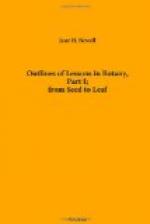Gray’s First Lessons. Revised edition. Sect. XVI, 445-7, 437.
How Plants Grow. Chap. III, 279-288.
II.
SEEDLINGS.
1. Directions for raising in the Schoolroom.—The seeds should be planted in boxes tilled with clean sand. Plates or shallow crockery pans are also used, but the sand is apt to become caked, and the pupils are likely to keep the seeds too wet if they are planted in vessels that will not drain. The boxes should be covered with panes of glass till the seedlings are well started, and should be kept at a temperature of from 65 deg. to 70 deg. Fahr. It is very important to keep them covered while the seeds are germinating, otherwise the sand will be certain to become too dry if kept in a sufficiently warm place. Light is not necessary, and in winter time the neighborhood of the furnace is often a very convenient place to keep them safe from frost. They should not be in the sun while germinating. When the first sprouts appear above the ground let another set be planted, and so on, till a series is obtained ranging from plants several inches high to those just starting from the seed. The seeds themselves should be soaked for a day and the series is then ready for study. The time required for their growth varies according to the temperature, moisture, etc. Dr. Goodale says they should be ready in ten days.[1]
[Footnote 1: Concerning a few Common Plants, by G.L. Goodale, Boston, D.C. Heath & Co. This little book, which is published, in pamphlet form, for fifteen cents, will be found exceedingly useful.]
I have never been able to raise them so quickly in the schoolroom, nor have the pupils to whom I have given them to plant done so at home. Generally, it is three weeks, at least, before the first specimens are as large as is desirable.
Germinating seeds need warmth, moisture and air. The necessary conditions are supplied in the very best way by growing them on sponge, but it would be difficult to raise enough for a large class in this manner. Place a piece of moist sponge in a jelly-glass, or any glass that is larger at the top, so that the sponge may not sink to the bottom, and pour some water into the glass, but not so much as to touch the sponge. The whole should be covered with a larger inverted glass, which must not be so close as to prevent a circulation of air. The plants can thus be watched at every stage and some should always be grown in this way. The water in the tumbler will keep the sponge damp, and the roots, after emerging from the sponge, will grow well in the moist air. Seeds can also be grown on blotting paper. Put the seeds on several thicknesses of moist blotting paper on a plate, cover them with more moist paper, and invert another plate over them, taking care to allow the free entrance of air.
If possible, it is by far the best way to have the seeds growing in the schoolroom, and make it a regular custom for the pupils to observe them every morning and take notes of their growth.




